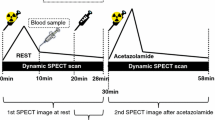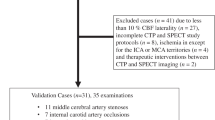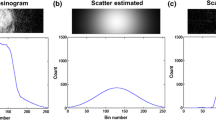Abstract
Rationale and objectives
As spreading integrated SPECT/CT scanners, reconstruction method based on three-dimensional ordered-subset expectation maximization (3D-OSEM) with attenuation correction (AC) using an X-ray CT image (CTAC) is easily available in brain imaging. For quantitative cerebral blood flow (CBF) measurements, however, the accuracy of this method has not been fully evaluated clinically. To validate this new algorithm, we sequentially studied quantitative PET-CBF and SPECT-CBF measurements in the same healthy volunteers and compared CBF values.
Methods
Ten healthy subjects underwent quantitative PET-CBF and SPECT-CBF measurements on the same day. PET-CBF data were obtained by the intravenous injection of O-15 water and the quantitative IMP-ARG method followed. Three types of SPECT images were reconstructed: (1) filtered back projection (FBP) with Chang’s AC (FBP + Chang’s AC), (2) 3D-OSEM with Chang’s AC (3D-OSEM + Chang’s AC), and (3) 3D-OSEM with CTAC (3D-OSEM + CTAC). The mean CBF difference, the linearity, and the correlation between the PET-CBF and SPECT-CBF values were compared among the SPECT reconstruction algorithms.
Results
The mean SPECT-CBF values of all the algorithms were significantly lower in the pons (P = 0.000–0.007) and higher in the frontal lobe (P = 0.002–0.022). All the SPECT-CBF values were significantly correlated with the PET-CBF values (r = 0.749–0.829, P < 0.001). The SPECT-CBF values obtained using the 3D-OSEM + CTAC method showed the best regression with the PET-CBF values.
Conclusion
The present clinical study validated accuracy of CBF image reconstructed by the 3-D OSEM method with CTAC and the integrated SPECT/CT system.






Similar content being viewed by others
References
Ljungberg M, Strand SE. Scatter and attenuation correction in SPECT using density maps and Monte Carlo simulated scatter functions. J Nucl Med. 1990;31:1560–7.
Tsui BM, Zhao X, Frey EC, MaCartney WH. Quantitative single-photon emission computed tomography: basics and clinical considerations. Semin Nucl Med. 1994;24:38–65.
Hashimoto J, Kubo A, Ogawa K, Amano T, Fukuuchi Y, Motomura N, et al. Scatter and attenuation correction in technetium-99 m brain SPECT. J Nucl Med. 1997;38:157–62.
Liang Z, Ye J, Harrington DP. An analytical approach to quantitative reconstruction of non-uniform attenuated brain SPECT. Phys Med Biol. 1994;39:2023–41.
Chang LT. A method for attenuation correction in radionuclide computed tomography. IEEE Trans Nuci Sci. 1978;25:638–43.
Leong LK, Kruger RL, O'Connor MK. A comparison of the uniformity requirements for SPECT image reconstruction using FBP and OSEM techniques. J Nucl Med Technol. 2001;29:79–83.
Kauppinen T, Koskinen MO, Alenius S, Vanninen E, Kuikka JT. Improvement of brain perfusion SPET using iterative reconstruction with scatter and non-uniform attenuation correction. Eur J Nucl Med. 2000;27:1380–6.
Brambilla M, Cannillo B, Dominietto M, Leval L, Secco C, Inglese E. Characterization of ordered-subsets expectation maximization with 3D post-reconstruction Gauss filtering and comparison with filtered backprojection in 99mTc SPECT. Ann Nucl Med. 2005;19:75–82.
Olsson A, Ärlig Ǻ, Carlsson GA, Gustafsson A. Evaluation of reconstruction techniques in regional cerebral blood flow SPECT using trade-off plots: a Monte Carlo study. Nucl Med Commun. 2007;28:719–25.
Miller TR, Walhis JR. Clinically important characteristics of maximum likelihood reconstruction. J NucI Med. 1992;33:1678–84.
Zeintl J, Vija AH, Yahil A, Hornegger J, Kuwert T. Quantitative accuracy of clinical 99mTc SPECT/CT using ordered-subset expectation maximization with 3-dimensional resolution recovery, attenuation, and scatter correction. J Nucl Med. 2010;51:921–8.
Vija AH, Hawman EG, Engdahl JC. Analysis of a SPECT OSEM reconstruction method with 3D beam modeling and optional attenuation correction: phantom studies. IEEE Nucl Sci Symp Conf Rec. 2003;4:2662–6.
Römer W, Reichel N, Vija HA, Nickel I, Hornegger J, Bauts W, et al. Isotropic reconstruction of SPECT data using OSEM3D: correlation with CT. Acad Radiol. 2006;13:496–502.
Iida H, Akutsu T, Endo K, Fukuda H, Inoue T, Ito H, et al. A multicenter validation of regional cerebral blood flow quantitation using [123I]Iodoamphetamine and single photon emission computed tomography. J Cereb Blood Flow Metab. 1996;16:781–93.
Matsumoto K, Kitamura K, Mizuta T, Tanaka K, Yamamoto S, Sakamoto S, et al. Performance characteristics of a new 3-dimensional continuous-emission and spiral-transmission high-sensitivity and high-resolution PET camera evaluated with the NEMA NU 2-2001 standard. J Nucl Med. 2006;47:83–90.
Ishikawa A, Kitamura K, Mizuta T, Tanaka K, Amano M. Implementation of on-the-fly scatter correction using dual energy window method in continuous 3D whole body PET scanning. Conf Rec IEEE NSS & MIC. 2005;5:2497–500.
Ferreira NC, Trebossen R, Lartizien C, Brulon V, Merceron P, Bendriem B. A hybrid scatter correction for 3D PET based on an estimation of the distribution of unscattered coincidences: implementation on the ECAT EXACT HR+. Phys Med Biol. 2002;47:1555–71.
Defrise M, Kinahan PE, Townsend DW, Michel C, Sibomana M, Newport DF. Exact and approximate rebinning algorithms for 3-D PET data. IEEE Trans Med Imaging. 1997;16:145–58.
Bailey DL, Meikle SR. A convolution-subtraction scatter correction method for 3D PET. Phys Med Biol. 1994;39:411–24.
Ibaraki M, Miura S, Shimosegawa E, Sugawara S, Mizuta T, Ishikawa A, et al. Quantification of cerebral blood flow and oxygen metabolism with 3-dimensional PET and 15O: validation by comparison with 2-dimensional PET. J Nucl Med. 2008;49:50–9.
Iida H, Kanno I, Miura S, Murakami M, Takahashi K, Uemura K. Error analysis of a quantitative cerebral blood flow measurement using H 152 O autoradiography and positron emission tomography, with respect to the dispersion of the input function. J Cereb Blood Flow Metab. 1986;6:536–45.
Ichihara T, Ogawa K, Motomura N, Kubo A, Hashimoto S. Compton scatter compensation using the triple-energy window method for single- and dual-isotope SPECT. J Nucl Med. 1993;34:2216–21.
Bland JM, Altman DG. Statistical methods for assessing agreement between two methods of clinical measurement. Lancet. 1986;1:307–10.
Iida H, Narita Y, Kado H, Kashikura A, Sugawara S, Shouji Y, et al. Effects of scatter and attenuation correction on quantitative assessment of regional cerebral blood flow with SPECT. J Nucl Med. 1998;39:181–9.
Shiga T, Kubo N, Takano A, Kobayashi J, Takeda Y, Nakamura F, et al. The effect of scatter correction on 123I-IMP brain perfusion SPET with the triple energy window method in normal subjects using SPM analysis. Eur J Nucl Med Mol Imaging. 2002;29:342–5.
Axelsson B, Msaki P, Israelsson A. Subtraction of Compton-scattered photon in single-photon emission computed tomography. J Nucl Med. 1984;25:490–4.
Ito H, Inoue K, Goto R, Kinomura S, Okada K, Sato K, et al. Detabase of normal human cerebral blood flow measured by SPECT: I. comparison between I-123-IMP, Tc-99m-HMPAO, and Tc-99m-ECD as referred with O-15 labeled water PET and voxel-based morphometry. Ann Nucl Med. 2006;20:131–8.
Nishizawa S, Tanada S, Yonekura Y, Fujita T, Mukai T, Saji H, et al. Regional dynamics of N-isopropyl-(123I)p-iodo-amphetamine in human brain. J Nucl Med. 1989;30:150–6.
Wilson DW, Tsui BMW. Noise properties of filtered-backprojection and ML−EM reconstructed emission tomographic images. IEEE Trans Nucl Sci. 1993;40:1198–1203
Rapisarda E, Bettinardi V, Thielemans K, Gilardi MC. Image-based point spread function implementation in a fully 3D OSEM reconstruction algorithm for PET. Phys Med Biol. 2010;55:4131–51.
Gantet P, Payoux P, Celler A, Majorel C, Gourion D, Noll D, et al. Iterative three-dimensional expectation maximization restoration of single photon emission computed tomography images: application in striatal imaging. Med Phys. 2006;33:52–60.
Snyder DL, Miller MI, Thomas LJ, Politte DG. Noise and edge artefacts in maximum likelihood reconstruction for emission tomography. IEEE Trans Med Imaging. 1987;6:228–38.
Turkington TG, Gilland DR, Jaszczk RJ, Geer KL, Coleman RE. A direct measurement of skull attenuation for quantitative SPECT. IEEE Trans Nucl Sci. 1993;40:1158–61.
Rajeevan N, Zubal IG, Ramsby SQ, Zoghbi SS, Seibyl J, Innis RB. Significance of nonuniform attenuation correction in quantitative brain SPECT imaging. J Nucl Med. 1998;39:1719–26.
Van Laere K, Koole M, Versijpt J, Dierckx R. Non-uniform versus uniform attenuation correction in brain perfusion SPET of healthy volunteers. Eur J Nucl Med. 2001;28:90–8.
Stodilka RZ, Kemp BJ, Prato FS, Nicholson RL. Importance of bone attenuation in brain SPECT quantification. J Nucl Med. 1998;39:190–7.
Licho R, Glick SJ, Xia W, Pan T-S, Penney BC, King MA. Attenuation compensation in 99mTc-SPECT brain imaging: a comparison of the use of attenuation maps derived from transmission versus emission data in normal scans. J Nucl Med. 1999;40:456–63.
Hayashi M, Deguchi J, Utsunomiya K, Yamada M, Komori T, Takeuchi M, et al. Comparison of methods of attenuation and scatter correction in brain perfusion SPECT. J Nucl Med Technol. 2005;33:224–9.
Sheehy N, Tetrault TA, Zurakowski D, Vija AH, Fahey FH, Treves ST. Pediatric 99mTc-DMSA SPECT performed by using iterative reconstruction with isotropic resolution recovery: improved image quality and reduced radiopharmaceutical activity. Radiology. 2009;251:511–6.
Acknowledgments
We thank the entire staff of the Department of Nuclear Medicine, Osaka Medical Hospital and Osaka University Graduate School of Medicine, for their help with the SPECT and PET data acquisition and the care of the subjects. We also acknowledge Keiko Takamoto and Satoru Nakanishi, Siemens-Asahi Medical Technologies, for their technical support with the image reconstruction methods using the present SPECT/CT scanner.
Author information
Authors and Affiliations
Corresponding author
Rights and permissions
About this article
Cite this article
Shimosegawa, E., Fujino, K., Kato, H. et al. Quantitative CBF measurement using an integrated SPECT/CT system: validation of three-dimensional ordered-subset expectation maximization and CT-based attenuation correction by comparing with O-15 water PET. Ann Nucl Med 27, 822–833 (2013). https://doi.org/10.1007/s12149-013-0752-2
Received:
Accepted:
Published:
Issue Date:
DOI: https://doi.org/10.1007/s12149-013-0752-2




